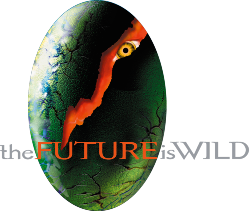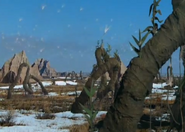| This article is a stub. |
| This article is shorter than it should be. You can help the The Future Is Wild Wiki by expanding it with relevant information. |

The Great Plateau is a plateau and mountain chain situated in the far north of the Australian-American Eurasian continent of 100 million AD.
Geography[]
By 100 million years Australia has completed its continental course drifting forward, furthermore with North America moving west, the continental drift has resulted in the collision of continents and given rise to the formation of massive mountainous ranges exceeding even the Himalayas of today, the tallest of which measuring over thirty-three-thousand feet high.
Climate[]
The great-plateau is one of the few ecoregions of the time that is considered cold in temperature-terms. As a result of the towering mountainous range, the atmosphere is rather low in oxygen, leaving the biosphere exposed to the harmful UV-rays.
Life[]

The Poggle, the last mammal

The Great Blue Windrunner, a four-winged bird

The Silver Spider, a spider that farms Poggles
While the Great Plateau appears lifeless, at least one species of plant lives here: the Grass tree. Where there are plants there are animals and highly specialised species have adapted to the vast cave systems. One inhabitant of the caves, one of the few remaining mammals left, the Poggle is found in caves located within the plateau. Another resident is the Silver spider, who feed on poggles and have constructed large webs in-between gorges. A migratory bird occasionally resides on the plateau: the Great blue windrunner, but only during breeding season.
Gallery[]
Behind the scenes[]
In "The Great Plateau," the Great Plateau was filmed in South Dakota's Badlands National Park and in Argentina's Iberá Provincial Reserve. Iberá, which is mainly swampland, was also used as a filming location in "Waterland".
List of appearances[]
- The Future Is Wild
- The Future Is Wild: A Natural History of the Future
- The Future Is Wild manga
- 05. Great Plateau
- The Future Is Wild animated series
- 1x03. Sky High Anxiety
- 1x17. Around the World In 80 Minutes
- 1x25. Queen of the Squibbons, Part 2
- The Future Is Wild: The Living Book
[]
| |||||||||||

